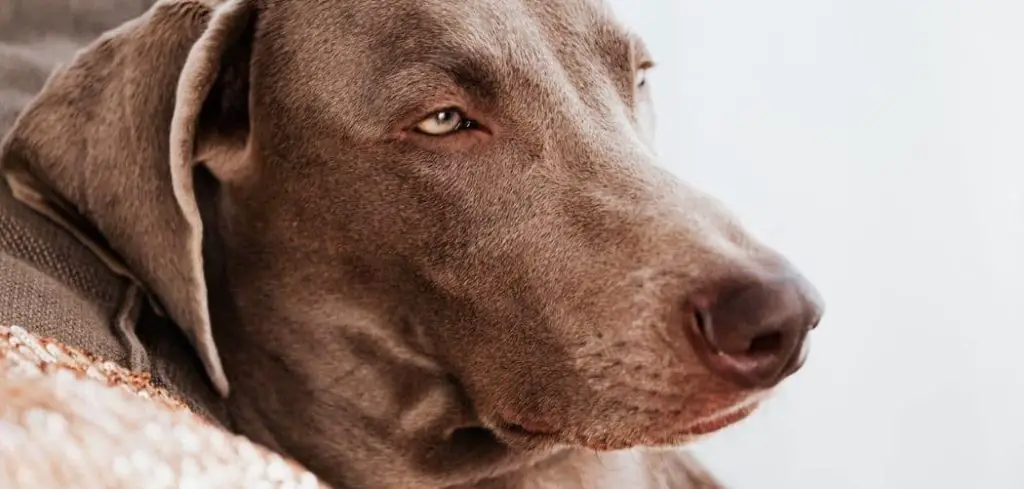Panting in dogs is a normal way to regulate body temperature, but when it is excessive or paired with other symptoms like weight loss, lethargy, or weakness, it can signal a serious underlying condition.
Cancer is one of the more concerning causes of persistent panting, especially in older dogs.
We outline the reasons why panting occurs in a dog with cancer, what you can do at home, and when to seek veterinary help.
Table of Contents
Dog Panting and Cancer — Why It Happens
Panting related to cancer can occur for several reasons, ranging from pain and anxiety to organ dysfunction and anemia. Tumors affecting the respiratory system, heart, or major organs can make breathing more difficult, prompting heavier panting.
Cancers that cause pain or discomfort can also trigger panting as a stress response. Also, certain cancers and their treatments can weaken the body, disrupt oxygen delivery, or raise body temperature, all of which contribute to abnormal breathing patterns.

Common Causes of Dog Panting and Cancer
Lung Cancer
When cancer originates in or spreads to the lungs, it can limit your dog’s ability to take in oxygen.
Panting becomes a way to compensate for reduced lung capacity. You might also notice coughing, wheezing, or rapid breathing.
Lung cancer in dogs can be primary or metastatic (spread from another site). It often goes unnoticed until breathing changes are visible, making early detection challenging.
Read more: Dog with cancer not eating and vomiting (Here’s why)
Lymphoma
Lymphoma is a cancer of the lymphatic system, which plays a vital role in immune function. It can cause panting if enlarged lymph nodes press on airways or if the disease spreads to the chest.
In some cases, chemotherapy used to treat lymphoma may temporarily affect breathing patterns. Dogs with lymphoma may also show signs of lethargy, decreased appetite, or weight loss.
Hemangiosarcoma
This aggressive cancer often affects the spleen, heart, or liver. When it involves the heart (cardiac hemangiosarcoma), fluid can build up around the heart and lungs, leading to difficulty breathing and panting.
A sudden collapse, weakness, or pale gums alongside panting can indicate internal bleeding from a ruptured tumor—a life-threatening emergency.
Mast Cell Tumors
These tumors can release histamine and other chemicals into the bloodstream, sometimes causing systemic reactions like increased heart rate, inflammation, and panting.
Severe allergic-type reactions may develop if the tumor is disturbed or spreads, and internal organ involvement can worsen respiratory effort.
Bone Cancer (Osteosarcoma)
While bone cancer primarily affects the limbs, it can cause intense pain. Pain-induced panting is a common sign in dogs with osteosarcoma, even if there is no direct effect on the lungs.
As the disease progresses, bone cancer can metastasize to the lungs, compounding breathing issues.
What to Do If Your Dog Is Panting and Has Cancer
If your dog has been diagnosed with cancer and is panting excessively, ensure they are in a calm, comfortable environment. Keep the room cool, offer fresh water, and minimize stress or physical exertion.
Monitor their breathing rate and effort closely. If they seem restless, in pain, or unable to lie comfortably, this could indicate worsening symptoms.
Speak with your vet about pain management, anti-anxiety medications, or supplemental oxygen therapy if needed. Never give human medications without veterinary guidance, as many are toxic to dogs.
When to Call or Visit Your Vet
Contact your veterinarian immediately if your dog:
Is panting heavily at rest.
Has pale or blue gums.
Shows signs of collapse or sudden weakness.
Has labored or open-mouth breathing.
Appears to be in pain despite medication.
These could be signs of severe complications such as internal bleeding, respiratory distress, or advanced disease progression that require urgent care.
Key Takeaway
Panting in a dog with cancer can be a sign of discomfort, organ involvement, or a medical emergency. Stay alert to changes in breathing, behavior, and energy levels.
Work closely with your veterinarian to manage symptoms and ensure your dog’s comfort. Timely veterinary intervention can make a significant difference in your pet’s quality of life and may even extend the time you have together.
